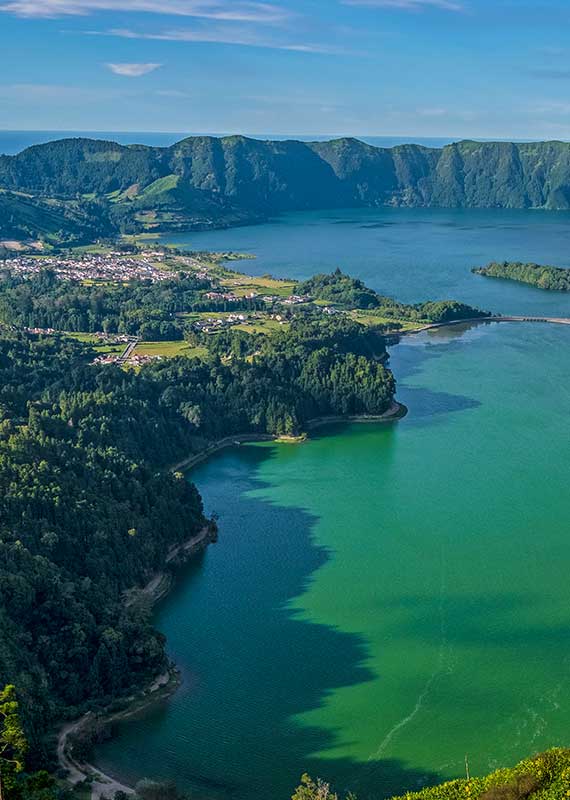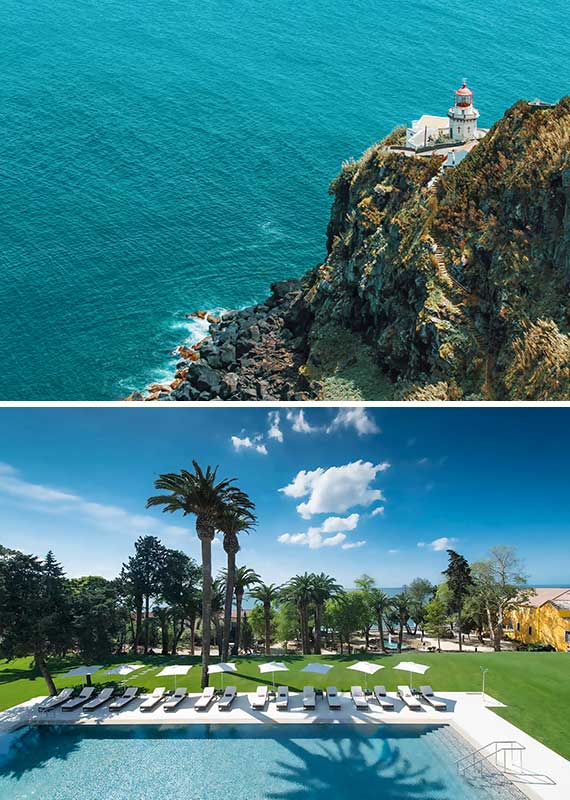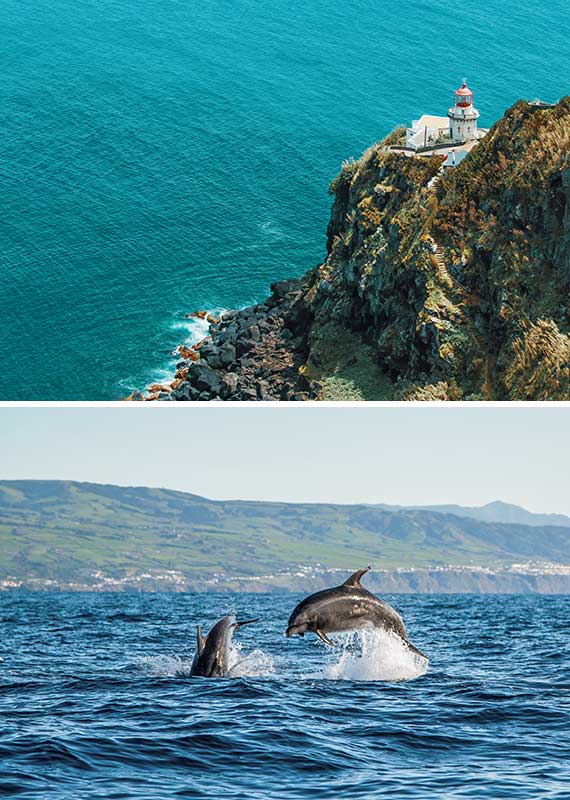São Miguel: the crown jewel of the Azores, where raw beauty meets rich biodiversity, oceanic adventures and culinary delights
 Lagoa das Sete Cidades – a twin lake in the crater of a dormant volcano
Lagoa das Sete Cidades – a twin lake in the crater of a dormant volcano
The Azores is a magical, mythical place, not least because it seems so out of the way – this mid-Atlantic archipelago comprises nine volcanic islands roughly 1,000 miles (give or take) west of Lisbon, northwest of Morocco, and southeast of Newfoundland. Fair to say it’s in the middle of nowhere – but therein lies its romantic draw. Thanks to Portugal’s TAP Air, visitors can now enjoy flights to two of the region’s most iconic islands, São Miguel, and Terceira, via a leisurely stopover in Lisbon.
Our journey to São Miguel really starts at TAP’s business class lounge where we fill up on finger food and chilled wines, before our onward flight that results in the most spectacular views as we descend into this verdant, misty world. Affectionately known as The Green Island, São Miguel epitomises the natural beauty of the region. Here, the landscape is a tapestry of lush greenery, punctuated by geothermal wonders such as steaming fumaroles and thermal pools, and the island’s climate, often a clash of all four seasons in a day, nurtures an extraordinary biodiversity.
There’s more than enough time to explore, but first, sustenance. We head to boutique hotel Senhora da Rosa’s Magma restaurant, where we indulge in a perfectly curated fine dining experience, and the company of the largerthan- life Eduardo Elias, whose Azorean knowledge is second-to-none.
 Top: Ribeira Grande (Photography by Tom Swinnen), Bottom: Vila Galé Collection Palácio dos Arcos
Top: Ribeira Grande (Photography by Tom Swinnen), Bottom: Vila Galé Collection Palácio dos Arcos
We lap up our tour guide’s myriad historical and local facts as we enjoy a slap-up meal, and it is a perfect, and surprisingly educational, evening. One of the main attractions here is whale watching, and we are beyond excited to go out on the waters with eco-tour operator Terra Azul, whose passionate and knowledgeable team of marine biologists sit us down for a safety briefing, but also a discussion on how we can all do our bit for the ocean. Humans need nature, but nature does not need humans is the main takeaway. Before long, we’re hurtling across the sea, keeping our beady eyes out for signs of these magnificent creatures, and we, the tourists, become part of the research team – any sightings will be duly noted and recorded. Schools of dolphins know how to put on a show as they playfully leap around us, but sadly, this time, the whales remain as mythical as the island’s misty vistas. We’re told yesterday’s excursion proved far more fruitful, and so we vow to return, one day.
Beyond the thrill of marine pursuits, São Miguel offers a compelling landscape forged by volcanic activity, and the best way to see it is to jump in the back of a jeep and go off-roading. We visit the insanely picturesque terrains of Sete Cidades, Mosteiros, and Ferraria, and we visit the geothermal heart of Furnas. The area is renowned for its vibrant scenery dotted with active volcanic sites and bubbling calderas. It is only here that you get a true sense of the earth being alive beneath your feet. At the centre of this natural spectacle lies the beautiful Terra Nostra Park, home to a vast thermal pool infused with iron, offering a soothing retreat at a balmy 40C. It would be rude not to jump in and soak up all the mineral goodness, even if the water is an opaque muddy orange and too dense to properly swim in. It is an unforgettable experience.

There’s no shortage of exquisite dining destinations on the island, with a focus on locally caught fresh fish and pasture-raised meat, and we get our fill at Pedras do Mar, Meia Nau, and WHITE hotel’s elegant Cardume. The main gastronomic event, though, is with local chef Henrique Mouro at À Terra, who has us donning aprons and peeling veg, while he explains the significance of the uniquely Azorean dish we are creating – Cozido das Furnas, or volcano cooked stew. Once we’ve piled up the pot with pork, potatoes, carrots and onions, it is whisked away – as are we – to a nearby volcanic site, where the pot is essentially buried, the island’s geothermal heat slowly cooking its contents to perfection, to be exhumed and later consumed that evening in the luxury of the modern, buzzy restaurant. Our stay on the island has been nothing short of magical, but we leave in the knowledge that a full 26-hour stop-over in Lisbon awaits, which more than softens the blow of our departure. We have plans to hit the town, but when we step inside our tranquil home for the remainder of our trip, the stately and serene Vila Galé Collection Palácio dos Arcos, it is a no-brainer: the Avenida de Liberdade can wait. Nestled along the picturesque coastline of Paço de Arcos, the boutique hotel stands as a testament to Portugal’s mix of rich history and modern luxury. This five-star gem opened its doors in 2013 following a meticulous restoration that preserved the grandeur of its late fifteenth-century origins and its subsequent eighteenth-century revival. Today, the building is rendered in the brightest canary yellow, making it a sunshiny standout, but also reminding us of its effortless blend of old and new.
Its royal heritage is palpable, too. Legend has it that from the palace’s elegant balconies, King Manuel I watched the caravels set sail for India, and we cannot help but feel entirely regal here as we take in the exquisite architecture and sumptuous antique furnishings.
The perfect end to our trip comes in the form of a lazy afternoon spent reading and relaxing by the warm, outdoor pool – the weather has been kind to us, and we bask in the sun, before we dress for one last dreamy, hosted dinner in our majestic private dining room, in which we truly feel like kings and queens. And we are so grateful to have experienced it via our Azores trip. All holidays should end like this, we declare over our third glass of Val Moreira Vinha D’Arte – let’s redefine the stopover.


